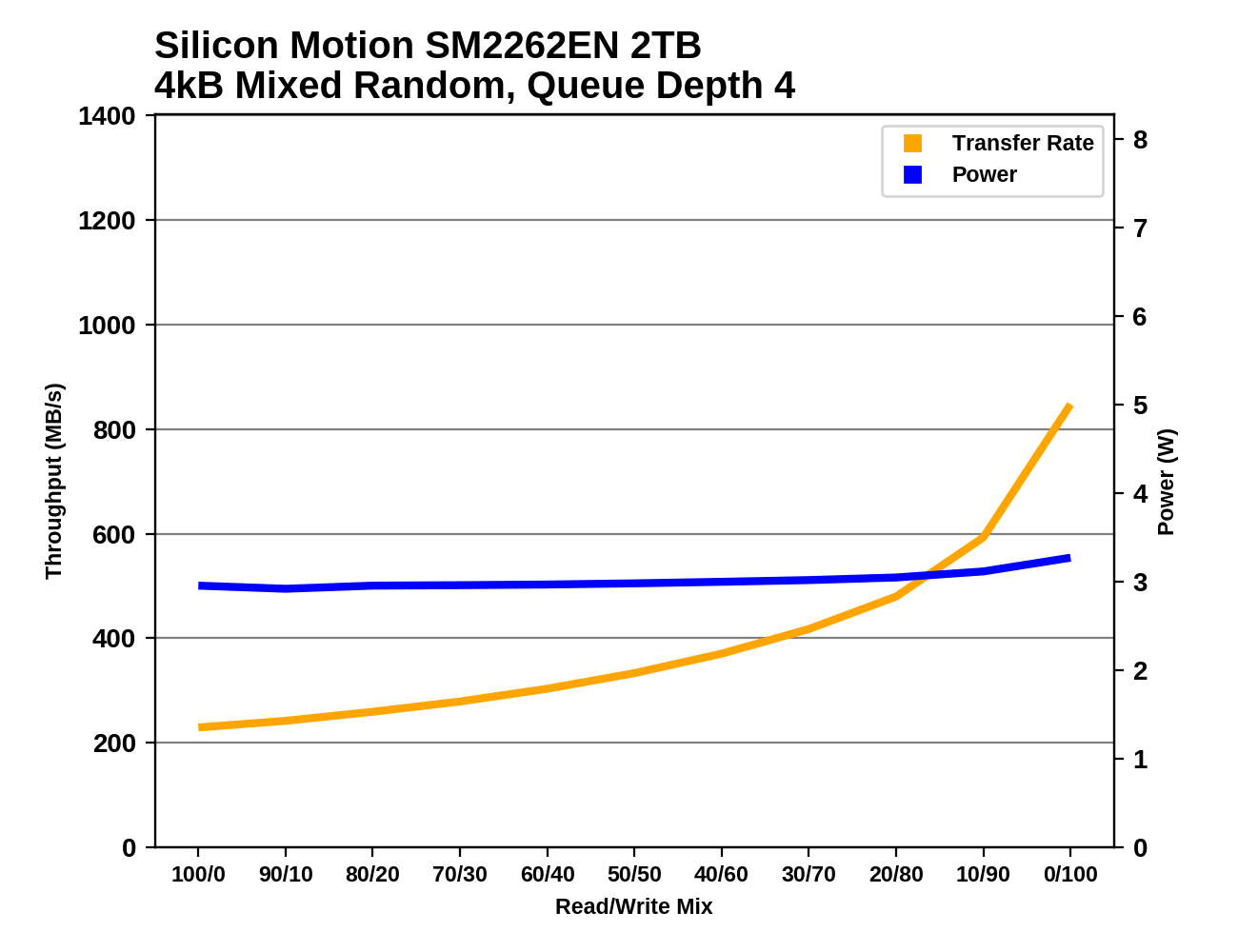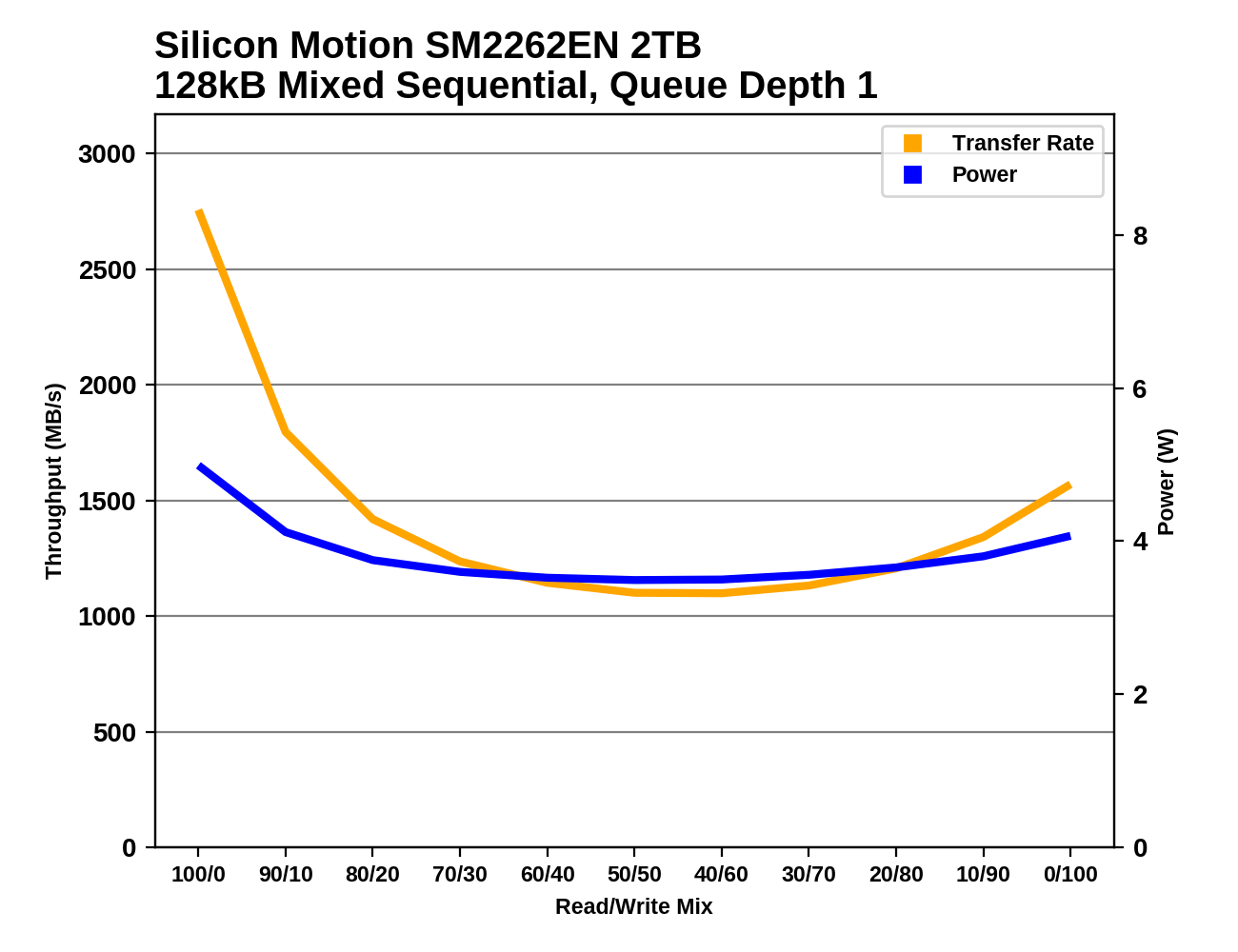The Silicon Motion SM2262EN SSD Controller Preview: Good And Bad Amplified
by Billy Tallis on August 1, 2018 11:45 AM ESTMixed Random Performance
Our test of mixed random reads and writes covers mixes varying from pure reads to pure writes at 10% increments. Each mix is tested for up to 1 minute or 32GB of data transferred. The test is conducted with a queue depth of 4, and is limited to a 64GB span of the drive. In between each mix, the drive is given idle time of up to one minute so that the overall duty cycle is 50%.

The Silicon Motion SM2262EN takes the lead among flash-based SSDs for mixed random I/O performance, though by a margin that is small enough that it may be due entirely to the capacity advantage over the 1TB 970 EVO. The performance is a clear improvement over the already-great HP EX920.
 |
|||||||||
| Power Efficiency in MB/s/W | Average Power in W | ||||||||
Power efficiency for the SM2262EN has improved but is not quite in the top tier for flash-based SSDs. Total power draw is higher than most SSDs, but 3W isn't a problem given the performance.
 |
|||||||||
The SM2262EN shows very similar performance scaling to other top drives, with slow growth during the early phases of the test while the workload is still read-heavy, but accelerating as the proportion of writes increases. There are several drives that outperform the SM2262EN in the final phase of pure random writes, but the it tends to dominate all the earlier phases.
It is also interesting to note that power consumption barely ticks up for the final phase where the SM2262EN has a respectable spike in performance.
Mixed Sequential Performance
Our test of mixed sequential reads and writes differs from the mixed random I/O test by performing 128kB sequential accesses rather than 4kB accesses at random locations, and the sequential test is conducted at queue depth 1. The range of mixes tested is the same, and the timing and limits on data transfers are also the same as above.

The SM2262EN is outclassed by several other TLC drives on the mixed sequential I/O test, but it is still clearly within high-end performance territory and is an improvement over the SM2262 drives.
 |
|||||||||
| Power Efficiency in MB/s/W | Average Power in W | ||||||||
The SM2262EN uses less power than its predecessors on this test while offering a modest performance improvement, so its efficiency score is substantially higher. However, several other TLC drives are still ahead, led by the WD Black.
 |
|||||||||
The performance scaling curve of the SM2262EN is very similar to the SM2262-based HP EX920, except that the EX920 falls behind during the more write-heavy half of the test. The SM2262EN manages to stay well above 1 GB/s throughout the test. The fastest drive run this test on is the Samsung 970 EVO, which doesn't lose performance as quickly as writes are added to the mix, but it ends up performing almost the same as the SM2262EN during the second half of the test.










28 Comments
View All Comments
Billy Tallis - Wednesday, August 1, 2018 - link
The sustained I/O synthetic tests move far too much data for DRAM caching of user data to have much impact. The burst I/O tests could theoretically benefit from using DRAM as a write cache, but it doesn't look like that's the case based on these results, and I don't think Silicon Motion would really want to add such a complication to their firmware.leexgx - Saturday, August 4, 2018 - link
don't think any SSD has used the DRAM as cache (only used for PAGE table) i could speed things up a little but your still limited by the NAND speed any way, Writing directly to NAND makes more senseMikewind Dale - Thursday, August 2, 2018 - link
That drop in performance in the Heavy test, going from empty to full, was horrifying. I'd like to see some additional tests where the drive gets progressively closer to full. At what point does the drive's performance plummet? Is it gradual or sudden?With other drives, it doesn't matter so much. Most of them have approximately (within 10-20%) the same performance when empty or full, so a person using a full drive will still get approximately the same experience no matter how much they use the drive. But the SM2262EN loses about 80%(!!!!) of its performance when full. So it would be important to know how quickly or gradually this loss occurs as the drive fills.
jjj - Thursday, August 2, 2018 - link
Any chance you are going to the Flash Memory Summit? Might be an interesting year.Billy Tallis - Thursday, August 2, 2018 - link
Yep, we'll be at FMS next week. Tuesday is going to be a very busy day.jjj - Thursday, August 2, 2018 - link
Great, looking forward to your reports!Death666Angel - Thursday, August 2, 2018 - link
Considering this thing is still in a beta state, I don't think any further investigation into the full state performance is beneficial to us consumers. But if a SM2262EN SSD hits the shelves and is buyable, then a look into different states of fullness and the corresponding performance will be greatly appreciated. :D Good test and SSD controller so far.DigitalFreak - Thursday, August 2, 2018 - link
I would definitely like to see this with a retail drive.iwod - Thursday, August 2, 2018 - link
So have we reached peak SSD? If even Optane don't give us any user perceived performance, then surely user would choose larger capacity SSD than 3GB/s vs 2GB/s SSD.Right now we need price to drop faster. 500GB PCI-E SSD with 1GB/s + Speed should be under $100.
rpg1966 - Thursday, August 2, 2018 - link
"Silicon Motion's second-generation NVMe SSD controllers have all but taken over the consumer NVMe SSD market. Drives like the HP EX920 and ADATA SX8200 currently offer great performance at prices that are far lower than what Samsung and Western Digital are charging for their flagship products."This (kind of) implies that the controller is the biggest cost element of a drive. Does anyone have a rough breakdown of parts costs for a drive like this, i.e. controller, DRAM, NAND, and the board+ancillaries?